|
|
| |
|
|
| |
|
|
|
|
| |
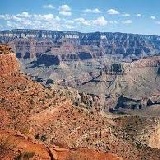 Travel
America Travel
America
Learn before you travel. This section of Fun Easy
English focuses on facts and other cool stuff about
your favorite U.S. state. This is great English
reading practice. This page focuses on the state of
Oklahoma. |
 Hey
if you cannot understand something on this page, Hey
if you cannot understand something on this page,
then use the Fun Easy English
dictionary
(opens in a new window) |
|
|
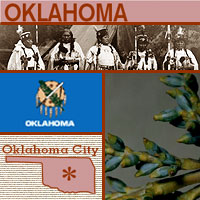 Oklahoma Oklahoma
The name Oklahoma comes from two Choctaw Indian
words, okla, which means "people," and humma, which
means "red." In 1889, Congress opened up 2 million
acres for white settlement (it was previously open
only to Native Americans who were forced to leave
their homelands), and the first of a number of land
runs began. Some of the state's settlers were called
"Sooners" because they had already staked their land
claims before the land was officially opened for
settlement. Oklahoma was admitted as the 46th state
in 1907. Oklahoma's capital is an easy one to
remember--Oklahoma City. The state flower is the
mistletoe, a favorite for kissing under during the
winter holidays. |
|
Oklahoma
State Flag
The current state flag of Oklahoma, designed by
Louise Fluke, was adopted in 1925 (Oklahoma had 13 previous
flags).
The blue field signifies devotion, the shield is a symbol of
defensive or protective warfare, but always surmounted by
the olive branch and peace pipe which betoken the love of
peace by a united people.
Official Salute to the Oklahoma State
Flag
"I salute the flag of the State of Oklahoma. Its symbols of
peace unite all people." |
|
Source:
State Symbols USA |
|
|
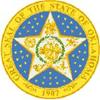 Oklahoma
State Facts Oklahoma
State Facts
Picture: state seal of Oklahoma |
|
State Capital |
Oklahoma City |
|
Nickname |
Sooner State |
|
Motto |
Labor Omnia Vincit (Labor Conquers All Things) |
|
Statehood |
November 16, 1907 (46th) |
|
Origin of Name |
Based on Choctaw Indian words: "okla" meaning people
and "humma" meaning red." |
|
Largest Cities |
Oklahoma City, Tulsa, Norman, Lawton, Broken Arrow |
|
Border States |
Arkansas, Colorado, Kansas, Missouri, New Mexico,
Texas |
|
Area |
68,679 sq. mi., 19th largest |
|
State Bird |
Scissor-tailed Flycatcher |
|
State Flower |
Mistletoe (phoradendron serotinum) |
|
State Tree |
Redbud (cercis canadensis) |
|
State Song |
Oklahoma |
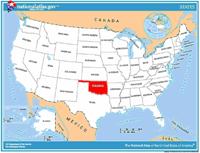 Travel and tourism site
for Oklahoma - This state travel and territorial
tourism site provides ideas for your vacations, meetings, and more. Travel and tourism site
for Oklahoma - This state travel and territorial
tourism site provides ideas for your vacations, meetings, and more. |
|
|
Oklahoma Stories |
|
|
The American Indian Exposition in Anadarko,
Oklahoma
Every year in August hundreds of Native American people from all
different tribes come to the city of Anadarko, Oklahoma. Named after
a Plains Indian tribe, Anadarko is now the home of one of the
largest gatherings of Plains Indians in Oklahoma. Because so many
Plains Indian populations have lived in Anadarko, it is known as the
"Indian Capital of the Nation."
This gathering of Native Americans is called the American Indian
Exposition. An exposition is a public exhibition or show. The
purpose of this exposition is to show off Native American arts and
crafts and help preserve their cultural heritage. The Native
Americans who attend sometimes camp out in traditional teepees and
they may wear traditional leather clothing, called buckskin. Lots of
people who are not Native Americans come to observe Indian culture;
they watch the parades or greyhound and horse racing, or they attend
one of the many dances or contests that are held.
Several months before the exposition, each tribe selects a tribal
princess who will represent them for a year. A tribal princess is
smart and strong. She must also possess a fine personality, be
self-confident, and have other qualities that make her a leader.
During the exposition, the princesses have the honor of leading
their tribes in the parades that begin and end the festivities. |
|
|
The Dust Bowl of Oklahoma
Did you know there was once a desert in Oklahoma called the Dust
Bowl?
During the great dust storms of the 1930s in Oklahoma, the weather
threw up so much dirt that, at times, there was zero visibility and
everything was covered in dirt. No matter how tightly Oklahomans
sealed their homes, they could not keep the dirt from entering. Dust
storms were the result of drought and land that had been overused.
Drought first hit the country in 1930. By 1934, it had turned the
Great Plains into a desert that came to be known as the Dust Bowl.
In Oklahoma, the Panhandle area was hit hardest by the drought.
The land of the southern plains, including Oklahoma, was originally
covered with grasses that held the fine soil in place. Settlers
brought their traditional farming techniques with them when they
homesteaded the area and they plowed the land deeply. The topsoil
was already damaged by the overgrazing of cattle and sheep. The
situation was so serious that, by 1935, the government developed
conservation programs to improve the Dust Bowl by changing the basic
farming methods of the region. Even with these measures, the Dust
Bowl lasted about a decade and contributed to the length of the
Great Depression of the 1930s. |
|
|
Oklahoma State University Homecoming
What is a homecoming? If you think it refers to returning home, in a
way, you would be right.
A homecoming is when a school's alumni (students who have graduated)
return for a celebration. Every year, people who attended Oklahoma
State University in Stillwater, Oklahoma, are invited to a special
event-filled weekend called homecoming. One of the big events that
people look forward to is the homecoming parade, because it has many
colorful and unusual floats.
Usually a float is built on top of a flatbed trailer used for
transporting materials. The trailer is covered with colorful
material and fringe so its wheels are hidden and the trailer appears
to "float." Then the float can be decorated with just about
anything.
Many floats are in the form of animals. Floats are made by bending
chicken wire into a shape, perhaps an animal, and then attaching
colored paper "flowers" to the wire. Part of the process of building
a float involves "pomping" -- the stuffing of crepe paper or other
decorations into the wire frame of the float to make it look like
whatever it was designed to be.
Can you think of a cool float design? |
|
|
Pawnee, Oklahoma: Where the West Remains
How did someone named Gordon Lillie come to be called Pawnee Bill?
Pawnee Bill was born Gordon Lillie in 1860 and raised in Illinois.
When Gordon was 15, he moved to Pawnee, Oklahoma. He became a
teacher to the Pawnee Indians who lived there and they gave him the
nickname "Pawnee Bill." Because he loved the history of the Old West
so much, in 1883, Pawnee Bill left teaching to join the new Buffalo
Bill's Wild West Show, which featured exciting acts such as a bison
hunt. (You can learn more about Buffalo Bill in the "Amazing
Americans" section of this Web site.)
While Pawnee Bill was performing in Buffalo Bill's Wild West Show,
he met a woman named May Manning. Soon after they met, May married
Pawnee Bill and became May Manning Lillie. Then the couple started
their own Wild West show, with May as one of its star performers.
Pawnee Bill's Wild West Show was so popular that today it is still
re-created at Pawnee Bill's Buffalo Ranch in the town of Pawnee,
Oklahoma, for thousands of people to enjoy. |
|
|
The Route 66 Museum in Clinton, Oklahoma
Why would a museum be dedicated to a highway? Because Route 66 is no
ordinary highway.
Route 66 was built in 1932 and it runs from Chicago, Illinois, to
Los Angeles, California, then known as the "Promised Land." That's
2,400 miles of road! It is different from most other highways
because it takes a diagonal course instead of going in a straight
line. It was designed this way so that small towns would have access
to main roads, giving farmers the ability to transport grain and
produce. This two-lane road passes through eight states and three
time zones.
During the Great Depression, Route 66 was the road from Oklahoma and
the Dust Bowl to California and a better life, so it became known as
the "road to opportunity." Author John Steinbeck wrote about Route
66 in his classic The Grapes of Wrath, calling it the "Mother Road."
The Route 66 Museum was built in Clinton, Oklahoma, because Route 66
passes through 400 miles of Oklahoma. Dozens of artists have
recorded the song "(Get Your Kicks on) Route 66." Have you ever
heard it? |
|
|
Oklahoma Czech Festival
Have you ever eaten a kolache?
If you go to Yukon, Oklahoma, on the first Saturday in October, you
can. Every year, Yukon celebrates its Czech and Slovak ancestors.
Yukon is officially known as the Czechoslovak Capital of Oklahoma
because so many people from the country of Czechoslovakia, in
Eastern Europe, settled there in the late 1800s. (In 1993, the
country split into two nations, the Czech Republic and Slovakia.)
The most popular food from Czechoslovakia is a pastry called a
kolache (pronounced koh-lah-chuh). A kolache is a delicious, small
bun usually filled with fruit or cheese. In the Czech Republic and
Slovakia, no wedding feast is complete without them. One woman,
Maria Fiala, baked 600 dozen kolache for the festival and was named
Kolache Queen.
The Czech Festival is a way for the people in Yukon with Czech and
Slovak backgrounds to preserve and share their Czech customs,
clothing, and foods. One of the main attractions of the festival is
dancing. Lots of dance performances are held, and people of all
ages, like these kids in the beautiful costumes, are encouraged to
join in. If you aren't Czech or Slovak, the festival is a great way
to learn about their customs. |
|
|
Washita Battlefield National Historic Site
Have you ever heard of the Battle of Washita?
You can learn about this famous battle at the Washita Battlefield
National Historic Site in Oklahoma. This site is important because
it helps us remember the violent conflict between Indians of the
Great Plains and the United States Army.
The Great Plains include the land from the Canadian border south to
the New Mexico and Texas borders, and from the Missouri River west
to the Rocky Mountains. The Indian tribes from this area -- the
Plains Indians -- include the Cheyenne, Arapaho, and Kiowa. The Army
fought these tribes because they wanted to gain control over the
Great Plains.
For many years before and after the Civil War, the U.S. government
tried to move Indians to an Indian Territory (present-day Oklahoma).
Some Plains Indians agreed to move to reservations but others, like
the Cheyennes, Kiowas, and Comanches, did not. Instead, they
continued to live and hunt on traditional lands outside the Indian
Territory. After the Civil War, settlers wanted to move into this
land, so they attacked.
At dawn on November 27, 1868, Lieutenant Colonel George Custer
attacked a sleeping Cheyenne village in the Washita Valley,
surprising the Cheyenne's leader, Chief Black Kettle. Many Plains
Indians were captured or killed during this battle. Chief Magpie, a
teenager at the time who lived in Black Kettle's village, shot a
soldier and took his horse, then rode off to safety. He lived to
fight Custer again at the famous Battle of Little Bighorn in 1876. |
|
Source:
Library of Congress |
|
 National
Forests of Oklahoma National
Forests of Oklahoma
The following is a description of national
forests in the state
of Oklahoma. There are no national parks or
monuments in this state. If you plan to visit or live in
Oklahoma for awhile then you should
definitely plan to visit some of these
fantastic places. |
|
|
|
National Forests |
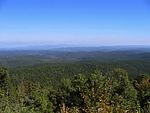 Ouachita Ouachita
Including the namesake Ouachita Mountains,
this forest has nearly 800,000 acres
(320,000 ha) of old-growth forest. The
forest has two wilderness areas: Black Fork
Mountain and Upper Kiamichi River. This
national forest is also partially located in
the state of Arkansas. |
|
|
|
|
|
|
|
|
|
|
|
|
Cool America |
 About the U.S.A. About the U.S.A.
About the U.S.A. is an American
Studies reader that examines the customs, government, and history of the
United States of America. The text provides a wealth of information on U.S.
geography and history; the roles of local, state, and federal government;
national holidays and symbols; the Constitution; and citizenship. The book,
which was written for intermediate to advanced learners of English, contains
a range of activities for language students to practice listening, speaking,
reading, and writing. (opens to a new PDF window)
Great English reading
practice. |
 About
America About
America
Learn about the fascinating history and government of
the United States of America. Lessons include content on
American Government, American History, and Integrated
Civics. Handouts with interactive games and
student-centered activities encompass all four language
skills: speaking, listening, reading, and writing.
Great English reading practice for
beginning to intermediate students. |
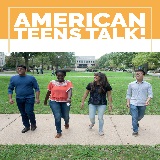 American Teens Talk! American Teens Talk!
Americans Teens Talk! is a collection of interviews of
American high school students. Each interview is accompanied by vocabulary
notes and discussion questions. The interviews in American Teens Talk! give
learners a view into the lives of adolescents in the U.S. Through the
written format of the interviews, learners are able to increase their
vocabulary, practice their reading and listening skills, engage in
discussions, and learn more about U.S. culture. These
interviews come with audio programs.
Great English listening and
reading |
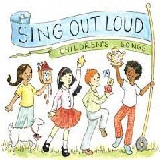 Sing Out Loud Children's Songs Sing Out Loud Children's Songs
Sing Out Loud Children's Songs includes popular children's songs in the U.S.A. Posters accompany the
individual Sing Out Loud Children's Songs. These
songs come with audio programs.
Great English listening and reading
practice. |
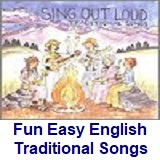 Sing Out Loud Traditional Songs Sing Out Loud Traditional Songs
The Sing Out Loud Traditional Songs
collection contains 13 traditional American folk songs and song lyrics.
Listen to the songs online, read the lyrics, and collect the posters that
accompany the songs. These
songs come with audio programs.
Great English listening and reading
practice. |
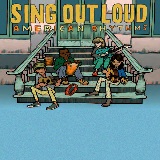 Sing Out Loud American Rhythms Sing Out Loud American Rhythms
Do you love music? Want to use it
to learn English? Check out the hip-hop inspired song "Peace" from Sing Out
Loud American Rhythms. American Rhythms includes a variety of musical genres
from many different artists in the U.S.A. These songs will appeal to teens
and young adults. These
songs come with audio programs.
Great English listening and reading
practice. |
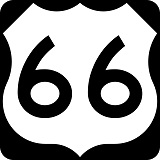 Route
66 - Famous American Road Route
66 - Famous American Road
U.S. Route 66 (US 66 or Route 66), also known as the Will Rogers Highway, the
Main Street of America or the Mother Road, was one of the original highways in
the U.S. Highway System. The highway, which became one of the most famous roads
in the United States, originally ran from Chicago, Illinois, through Missouri,
Kansas, Oklahoma, Texas, New Mexico, and Arizona before ending in Santa Monica,
California, near Los Angeles, covering a total of 2,448 miles (3,940 km). It was
recognized in popular culture by both the hit song "(Get Your Kicks on) Route
66" and the Route 66 television show in the 1960s. |
Route 66: The Highway That's the Best
(Beginner - Listening)
A video lesson which shows you an interesting place in America.
The English is
spoken at 75% of normal speed.
Great English listening practice.
This video shows travel along Route 66, the most famous road in
America. |
Chicago: The Start of Route 66
(Beginner - Listening)
A video lesson which shows you an interesting place in America.
The English is
spoken at 75% of normal speed.
Great English listening practice.
This video shows travel along Route 66, the most famous road in
America. |
Going West for Decades on Route 66
(Beginner - Listening)
A video lesson which shows you an interesting place in America.
The English is
spoken at 75% of normal speed.
Great English listening practice.
This video shows travel along Route 66, the most famous road in
America. |
Arizona: The Spirit of Route 66
(Beginner - Listening)
A video lesson which shows you an interesting place in America.
The English is
spoken at 75% of normal speed.
Great English listening practice.
This video shows travel along Route 66, the most famous road in
America. |
Route 66 California: The End of the Trail
(Beginner - Listening)
A video lesson which shows you an interesting place in America.
The English is
spoken at 75% of normal speed.
Great English listening practice.
This video shows travel along Route 66, the most famous road in
America. |
Ten Must-See Route 66 Attractions
(Beginner - Listening)
A video lesson which shows you an interesting place in America.
The English is
spoken at 75% of normal speed.
Great English listening practice.
This video shows travel along Route 66, the most famous road in
America. |
Four Famous Foods On Route 66
(Beginner - Listening)
A video lesson which shows you an interesting place in America.
The English is
spoken at 75% of normal speed.
Great English listening practice.
This video shows travel along Route 66, the most famous road in
America. |
International Tourists Drawn to Route 66
(Beginner - Listening)
A video lesson which shows you an interesting place in America.
The English is
spoken at 75% of normal speed.
Great English listening practice.
This video shows travel along Route 66, the most famous road in
America. |
|
|
|
|
Search Fun Easy English |
|
|
|
|
|
|
|
|
|
|
|
|
|
|
|
About
Contact
Copyright
Resources
Site Map |